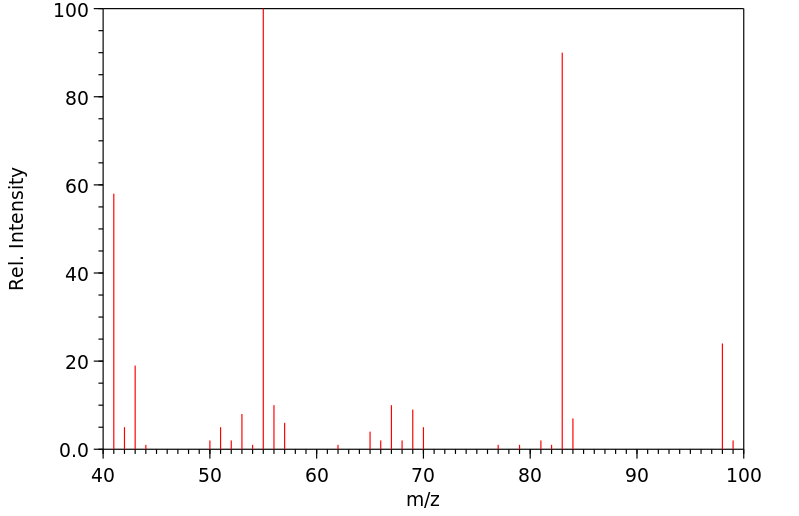4,4-dimethyl-pent-2-ene | 26232-98-4
中文名称
——
中文别名
——
英文名称
4,4-dimethyl-pent-2-ene
英文别名
4,4-dimethyl-2-pentene;4,4-dimethylpent-2-ene;α-Methyl-β-tert.-butyl-aethylen;4,4-Dimethyl-pent-2-en;2.2-Dimethyl-penten-(3);4.4-Dimethyl-penten-(2)
CAS
26232-98-4
化学式
C7H14
mdl
——
分子量
98.1882
InChiKey
BIDIHFPLDRSAMB-UHFFFAOYSA-N
BEILSTEIN
——
EINECS
——
-
物化性质
-
计算性质
-
ADMET
-
安全信息
-
SDS
-
制备方法与用途
-
上下游信息
-
文献信息
-
表征谱图
-
同类化合物
-
相关功能分类
-
相关结构分类
物化性质
-
沸点:84-86 °C
-
密度:0.7414 g/cm3(Temp: 0 °C)
-
熔点:-135.4 °C
-
保留指数:636.8;644
计算性质
-
辛醇/水分配系数(LogP):3
-
重原子数:7
-
可旋转键数:1
-
环数:0.0
-
sp3杂化的碳原子比例:0.71
-
拓扑面积:0
-
氢给体数:0
-
氢受体数:0
安全信息
-
海关编码:2901299090
SDS
反应信息
-
作为反应物:描述:参考文献:名称:Schurman; Boord, Journal of the American Chemical Society, 1933, vol. 55, p. 4932摘要:DOI:
-
作为产物:描述:4,4-二甲基-1-戊烯 在 platinum(II) acetylacetonate 三苯基硅烷 作用下, 反应 0.42h, 以98%的产率得到4,4-dimethyl-pent-2-ene参考文献:名称:线性烯烃的光活化异构化。摘要:研究了在硅烷存在下,铂(II)双(乙酰丙酮基)[Pt(acac)(2)]催化的线性烯烃的光催化(350 nm)异构化反应。催化活性取决于硅烷。三苯基硅烷是研究中最具活性的硅烷,辐照20分钟后,烯烃的异构化率超过98%。没有伴随的氢化硅烷化。对该机理进行了研究并提出了金属氢化物加成消除机理。DOI:10.1021/jo026176w
文献信息
-
A CONVENIENT SYNTHESIS OF α-BROMOKETONES FROM OLEFINS
-
Asymmetric synthesis of primary amines from alkenes and chiral chloronitroso sugar derivatives.作者:H. Braun、H. Felber、G. Kreße、A. Ritter、F.P. Schmidtchen、A. SchneiderDOI:10.1016/s0040-4020(01)86396-1日期:1991.1- 3 regioselectively at ambient temperature to give chiral hydroxylamines m 60 - 80% yield. In addition to these products of a formal ene reaction joined by a subsequent hydrolysis 2-substituted hydroxylamines 40 - 49 are also formed. The 2-substituted hydroxylamines 40, 41, 49 possess trans configurations exclusively. The product distribution is solvent dependent and susceptible to the addition of多种烯烃的5 - 15,38,39与chloronitroso糖衍生物反应1 - 3区域选择性地在环境温度下,得到手性羟胺米60 - 80%产率。除了这些产物通过随后的水解2-取代的羟胺加入正式烯反应的40 - 49也形成。2-取代的羟胺40,41,49具有反式构型排他。产物分布是溶剂依赖性的,并且易于添加亲核试剂。使用试剂的反应1在氯亚硝基官能团附近近似为镜像的图3和3产生产物的相反对映异构体。通过化学还原至胺阶段,然后形成非对映异构的樟脑磺酸或莫舍尔酰胺,然后进行色谱或NMR光谱分析,确定其光学纯度。发现环状产物的光学纯度超过89%ee,而无环烯烃产生的手性胺为50-90%ee。化学降解和与真实氨基酸的比较证实,在每种情况下均检查与D-甘露糖衍生物1的反应产生S-带有氨基官能团的不对称碳上的构型。因此,所研究的形式烯反应以可接受的化学收率和可预测的立体化学结果提供了另一种有用的EPC官能化手性胺合成方法。
-
A Versatile Tripodal Cu(I) Reagent for C–N Bond Construction via Nitrene-Transfer Chemistry: Catalytic Perspectives and Mechanistic Insights on C–H Aminations/Amidinations and Olefin Aziridinations作者:Vivek Bagchi、Patrina Paraskevopoulou、Purak Das、Lingyu Chi、Qiuwen Wang、Amitava Choudhury、Jennifer S. Mathieson、Leroy Cronin、Daniel B. Pardue、Thomas R. Cundari、George Mitrikas、Yiannis Sanakis、Pericles StavropoulosDOI:10.1021/ja503869j日期:2014.8.13intermediates play a major role and are generated by hydrogen-atom abstraction from substrate C-H bonds or initial nitrene-addition to one of the olefinic carbons. Subsequent processes include solvent-caged radical recombination to afford the major amination and aziridination products but also one-electron oxidation of diffusively free carboradicals to generate amidination products due to carbocationCu(I) 催化剂 (1) 由强碱性胍基部分的框架支撑,介导氮烯从 PhI=NR 来源转移到各种脂肪烃(CH 胺化或在腈存在下酰胺化)和烯烃(氮丙啶化)。产品概况与逐步而非一致的 CN 键形成一致。借助哈米特图、动力学同位素效应、标记立体化学探针以及自由基陷阱和时钟进行的机理研究使我们能够得出结论,碳自由基中间体起主要作用并且是通过从底物 CH 键或初始氮烯加成中提取氢原子而产生的到烯烃碳之一。随后的过程包括溶剂笼式自由基重组以提供主要的胺化和氮丙啶化产物,以及由于碳正离子的参与,扩散游离碳自由基的单电子氧化以产生酰胺化产物。通过变温电喷雾质谱法、循环伏安法和电子顺磁共振波谱法对金属和配体中心事件的分析,再加上计算研究,表明一种活性但仍然难以捉摸的铜氮 (S = 1) 中间体最初抽象分别来自 CH 和 C=C 键的氢原子或将氮烯添加到 CH 和 C=C 键,然后进行自旋翻转和自由基回弹,以提供包含分子内和分子间
-
Heterobimetallic Rebound: A Mechanism for Diene-to-Alkyne Isomerization with M---Zr Hydride Complexes (M = Al, Zn, and Mg)作者:M. J. Butler、A. J. P. White、M. R. CrimminDOI:10.1021/acs.organomet.7b00908日期:2018.3.26calculations, a heterobimetallic rebound mechanism for diene-to-alkyne isomerization has been proposed. This mechanism explains the origin of heterobimetallic control over selectivity: Mg---Zr complexes are too strongly bound to generate reactive fragments, while Al---Zr complexes are too weakly bound to compensate for the contrathermodynamic isomerization process. Zn---Zr complexes have favorable energetics研究了一系列M · Zr杂双金属氢化物与二烯和炔烃的反应(M = Al,Zn和Mg)。的反应中号·锆与导致二烯异构化为1,3-环辛二烯1,5-环辛二烯,但对于M =锌也导致对金属二烯到炔异构化。生成的环辛炔片段被困在Zr和Zn金属之间,形成的杂双金属物种对于M = Mg或Al不会形成。已经探索了二烯异构化和炔烃捕集的范围,从而导致了三种新的异双金属滑环金属环丙烯络合物的分离。通过动力学研究了二烯到炔烃异构化的机理。在Zn·Zr中反应是一阶的在高浓度的二烯,并进入与Δ ħ ‡ = 33.6±0.7千卡摩尔-1,Δ小号‡ = 23.2±1.7摩尔CAL -1 ķ -1,Δ ģ ⧧ ,298K = 26.7±1.2千卡摩尔- 1个,速率取决于二烯的性质。正激活熵提示涉及解离步骤。在DFT计算的基础上,提出了一种用于双烯-炔异构化的异双金属回弹机理。这种机制解释了异双金属控制选择性的起源:Mg ---
-
Carbon-13 nuclear magnetic resonance of organophosphorus compounds. III. Phosphorus heterocycles作者:George A. Gray、Sheldon E. CremerDOI:10.1021/jo00795a016日期:1972.11
表征谱图
-
氢谱1HNMR
-
质谱MS
-
碳谱13CNMR
-
红外IR
-
拉曼Raman
-
峰位数据
-
峰位匹配
-
表征信息
同类化合物
高密聚乙烯
香叶醇
顺式3-甲基-2-己烯
顺式-5-癸烯
顺式-5-甲基-2-己烯
顺式-5-庚烯-1-炔
顺式-4-癸烷
顺式-4-甲基-2-戊烯
顺式-4-甲基-2-戊烯
顺式-3-癸烯
顺式-3-甲基-3-己烯
顺式-3-甲基-2-庚烯
顺式-3-戊烯-1-炔
顺式-3,4-二甲基-3-己烯
顺式-3,4-二甲基-2-戊烯
顺式-3,4-二甲基-2-戊烯
顺式-2-甲基-3-己烯
顺式-2-壬烯
顺式-2-丁烯-D1
顺式-1.1.1-三甲基-2-丁烯
顺式-1-甲基-2-环丙基乙烯
顺式-1-甲基-2-乙烯基环戊烷
顺式-1-环戊基-1-辛烯
顺式-1-氘代-3-甲基-1-丁烯
顺式-(9ci)-2,3,3a,7a-四氢-4-(1-甲基乙基)-1H-茚
顺式-(2-丁烯基)环丙烷
顺式,顺式-2,4-己二烯
顺-环辛烯
顺-9-二十一碳烯
顺-6-十三碳烯
顺-5-甲基-1,3,6-庚三烯
顺-4-辛烯
顺-4-壬烯
顺-3-辛烯
顺-3-甲基-2-戊烯
顺-3-壬烯
顺-3-十三碳烯
顺-2-辛烯
顺-2-癸烯
顺-2-戊烯
顺-2-庚烯
顺-2-己烯
顺-2-丁烯
顺-2,2-二甲基-3-己烯
顺-1,3-戊二烯
顺,顺-1,9-环十六烷二烯
顺,顺,顺-环癸-1,3,5-三烯
间戊二烯
间二(4-吡啶基)苯
镁,二-2-丁烯基-







